
|
<<Back |
Aruba
October 5-12,
2007 |
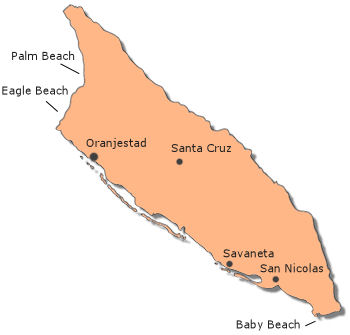
|
|
|
Although we spent a week in South
Carolina over the summer, the weather hadn’t fully
cooperated, and the beaches were suited more towards
collecting shells than relaxing with a tropical drink.
Thus, we were yearning for a trip to a sandy beach
lapped by clear blue water. We turned our attention
to the Caribbean, but being early October, we wanted
to minimize any intrusion by hurricanes on our idyllic
plans. We narrowed down our focus to the Dutch islands
of Bonaire, Curaçao, and Aruba situated just
off of the Venezuelan coast. These islands are rarely
subjected to hurricanes, and the temperature remains
between 80-90°F year round. A look at potential
flights from Boston pointed to Aruba as the most convenient
choice.
|
|
|
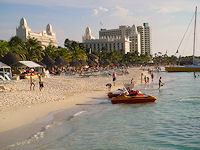
Palm Beach and the Riu Hotel.
|
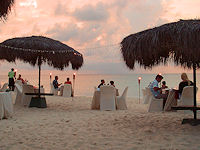
Surfside sunset suppers.
|
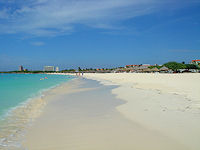
The less-populated Eagle Beach.
|
|
|
Unless you arrive by cruise
ship, you’ll most likely be staying in one of the
two hotel areas. The high-rise section contains the
big name hotels with large beaches, fancy restaurants,
and kiosks that peddle various watersport adventures.
By contrast, the low-rise area has smaller, more moderately-priced
hotels with quiet beaches and as many locals as tourists.
Separating the two zones is a short stretch of rocky
shoreline and a coastal wildlife refuge, but city
buses transport tourists between them regularly. We
opted for the quieter low-rise area around Eagle Beach.
Our hotel was nice enough with two pools, a pool bar,
a couple of hot tubs, and two rows of palapas on the
beach across the street. Once checked into our room,
we rummaged through our bags for our swimsuits, made
a stop at the bar to buy an icy bucket of Balashi
beer, and headed down to the beach to commandeer a
palapa.
During our stay, we pretty
much covered both hotel strips. The high-rise area
has a path running along the beach in front of the
hotels, and we walked the path in the daytime and
nighttime to get a flavor of each of the resorts.
The cream of the crop was definitely the Riu and the
Occidental with lots of marble, waterfalls, birds,
and even outdoor beds. These were all out of our price
range, plus they seemed too glitzy and crowded. We
were more than happy with our quaint little moderately-priced
hotel – or so we told ourselves. One the major factors
convincing us to choose Aruba came back to haunt us.
The fact that there are daily flights from Boston
and New York to Oranjestad means that Aruba is crawling
with Northeasterners. If your idea of paradise is
to watch a fat hairy-backed, Red Sox-capped, white
guy wading through the water with a cigarette in one
hand and a bottle of Bud in the other then Aruba is
the place for you.
|
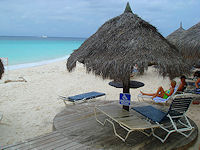
Handicapped parking.
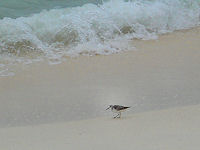
A sandpiper.
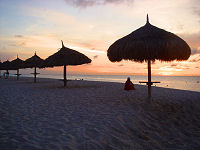
J enjoys another Aruban sunset
among the palapas.
|
|
|
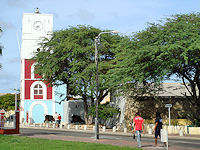
Fort Zoutman.
|
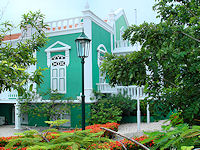
Stadhuis
|
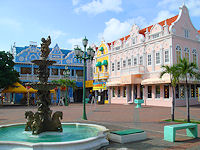
Downtown Oranjestad.
|
|
|
Once we completed our tour
of the hotel areas, we decided to venture into Oranjestad.
As with most Caribbean islands, the capital city is
situated on the leeward side of the island, only a
short bus ride from the low-rise hotels. Much of Oranjestad
lines Lloyd G. Smith Blvd, the strip that runs the
length of the harbor where the cruise ships dock.
The area hosts scores of bars and jewelry shops but
is also home to Wilhelmina Park where one can relax
and receive a full iguana experience. All of this
area was created from landfill in the 1930’s, a fact
illustrated a block inland by the 18th century Fort
Zoutman which was built on the then-shoreline to protect
the island from the threat of pirates.
Feeling a little peckish, we
wandered further into town where we found more pastel-colored,
Dutch-gabled buildings and restaurants specializing
in a wide range of cuisines. We settled on a place
serving Dutch pannekoeken - large crepes
filled with meat and cheese. Of course, J ordered
the sweet version with a fruit and ice cream filling.
Without a clear plan in mind, we moseyed around town
stopping in some of the various establishments to
enjoy a mojito or a margarita before heading back
to the hotel for a sunset dinner on the beach.
|
|
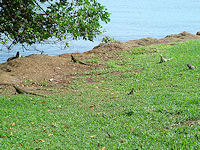
Gangs roam the park looking
for trouble.
|
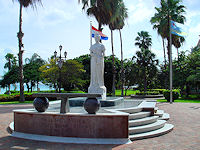
Queen Wilhelmina Park.
|
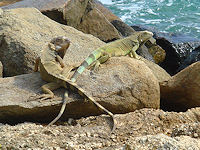
Iguanas getting some ray action.
|
|
|
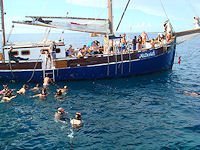
Fellow snorkelers.
|
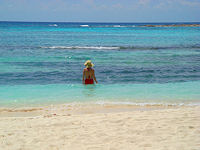
J tests the water at Baby Beach.
|
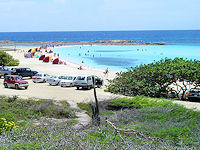
Baby Beach
|
|
|
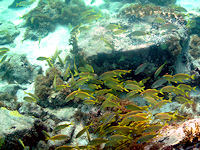
A school of reef fish.
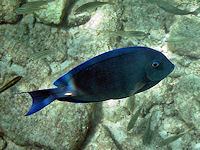
A parrot fish eyeballs us suspiciously.
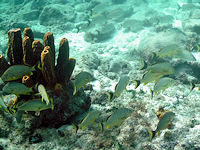
Pipe coral
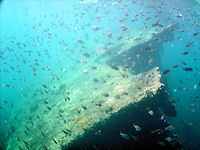
A view of the Antilla.
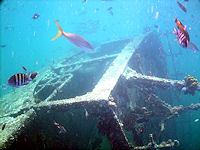
The sunken freighter.
|
We heard that some of the best
snorkeling in Aruba was to be had at Baby Beach. Unfortunately,
this beach was located at the southern tip of the
island, and we were in need of transportation. While
we were by now well-acquainted with the bus from the
tourist hotels to Oranjestad, we had not ventured
any further. To our frustration, we could not find
a single bus schedule or route map anywhere nor could
we find anyone, including our hotel services rep,
who could tell us where to get one. Apparently, tourists
don’t take the bus beyond Oranjestad since the bus
station there is no more than a café. With
the help of a friendly bus driver, we found the right
transfers to get us to San Nicolas, home of the nation’s
largest employer – the Valero oil refinery. But it
was also the bus terminus meaning we were on our own
to make it the rest of the way. After buying a few
pastechis from a local shop for breakfast,
we walked around what appeared to be the seedier part
of San Nicolas looking for a taxi. This was definitely
not tourist area, be we managed to hail a cab whose
driver agreed to take us to the beach. The driver
was understanding of our predicament, gave us his
card, and insisted that we call him when we needed
a lift back.
Baby Beach was truly delightful
- a soft white sand crescent around an aquamarine
lagoon. We found a nice spot near some divi divi
trees which we could use for shade if necessary.
The beach began to fill up as the day progressed,
but most of the sunbathers appeared to be locals which
was not too surprising considering the hotels were
on the other end of the island. Snorkeling in the
lagoon provided some glimpses of a few colorful fish,
but the real action was out by the breakers where
we found brain coral, pipe coral, and some pretty
fearless large fish. Three hours later, we returned
to shore, and our jaws dropped at the sight of our
bright red backs. It was going to be a painful night.
To make matters worse, we called our taxi man who
refused to pick us up because a cruise ship was coming
in and meeting it would be more lucrative. Thanks
to the kindness of some fellow travelers, we hitched
a ride back to our hotel in their rental car.
Though we were both in pain
from our snorkeling, we had booked a trip to snuba
– snorkeling with an air line- near the wreck of an
old German freighter. The voyage was all you can drink
which helped dull the pain, and we received some quick
lessons on the snuba technique before we were allowed
to go on our own. It took some getting used to, but
we were able to dive to about 15 feet which gave us
a nice view of the freighter. From time to time, D
felt a stinging sensation on his arm which caused
him to freak out and frantically wave his arms around
like a man possessed - a truly comical sight. Our
guide told us they were called pico pico and
that the rash would go away in a few hours. So between
numerous cocktails, too much sun, and stinging aquatic
organisms, we decided to hang up our swim fins for
the rest of the trip.
|
|
|
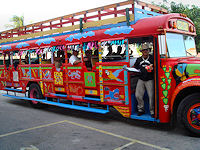
The Kukoo Kunuku party bus.
|
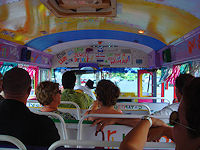
Mr. Smooth gets us underway.
|
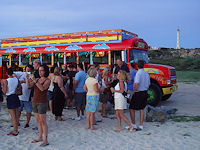
A sunset champagne toast.
|
|
|
Our research prior to arriving
in Aruba indicated that there was one adventure that
we just couldn’t miss – the Kukoo Kunuku bus. For a
moderate fee, this bus of rowdies will whisk you around
to a handful of bars for a night out on the town.
We made our reservations online the day before and
waited at our designated pick-up point around dinnertime.
This seemed like a perfect opportunity for J to really
let loose after weeks of working overtime to finish
a priority project. But as the kaleidoscopic bus pulled
up with blaring salsa music and screaming passengers,
we began to have second thoughts. We were greeted
by The Stripper and Mr. Smooth who checked our names
and issued us our maracas. The first stop was a champagne
toast near Arashi Beach to watch the sun set and rendezvous
with the other bus. The owner of this enterprise laid
down the ground rules, of which there was only one
– have a good time. The evening’s plan included dinner
at a traditional Aruban cunucu homestead
and then on to five local nightspots for a drink at
each. Our fellow passengers were a healthy mix of
old timers and newlyweds, most of whom shared our
apprehension of what we had gotten ourselves into.
Dinner wasn’t anything special, but it gave us the
opportunity to get to know some of the people on the
bus and to have a few kickoff drinks. Of course, the
real reason for the dinner was to get some food in
our stomachs and have the opportunity to purchase
some Kukoo Kunuku souvenirs.
We were already feeling pretty
good when we loaded ourselves back on the bus to head
out to the first bar. The music was blaring, maracas
were shaking, the passengers were drinking, and Mr.
Smooth, our driver, spun us around every traffic circle
three times to warn off all other motorists. The price
of admission included dinner and one drink at each
of the bars on our route; however, if you buy the
official Kukoo Kunuku koozie, the bars will fill it
instead of the much smaller house glass. We went for
the deal, and it definitely paid off – especially
when you consider the amount of booze J would have
spilled without it as the night progressed. To our
surprise and delight, we did not make stops at the
regular tourist traps in and around Oranjestad, but
rather were taken to hangouts where the locals cut
loose. Each successive stop escalated the infectious
partying atmosphere on and off the bus. Now fully
into the swing of things, J led the charge as we made
our final stop. This particular club had a stage in
the corner that included a pole. Decorum prevents
us from posting images of J’s pole dancing prowess
here, but suffice it to say that it was memorable
to all present. It was sometime after 1 am when the
bus, music still blasting and passengers screaming
"Aay Parrandaaa!", delivered us at our hotel.
|
|
|
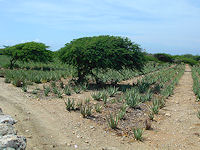
Aloe fields.
|
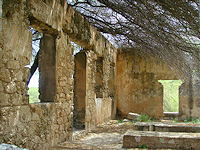
Balashi gold mill ruins.
|
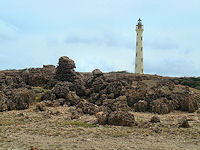
California Lighthouse.
|
|
|
The island of Aruba has had
a somewhat peculiar history. It was originally settled
by the Arawak tribe of Caquietios natives from Venezuela
whose presence is commemorated by drawings on some
of the rock formations around the island. From a European
perspective, the Spanish discovered the island at
the end of the 15th century and were responsible for
its name – a derivative of oro hubo suggesting
a presence of gold. Aruba’s arid climate did not offer
much for the Spanish other than ranching, so they
enslaved the entire Arawak population and relocated
them to the northern Caribbean island of Hispaniola
to work the mines. Eventually many of the Arawak returned
to their native island to live alongside the Spanish.
Towards the end of the Eighty Years War, the Dutch
wrestled Aruba away from the Spanish and began serious
colonization. The English briefly took control of
the island for a decade during the Napoleonic Wars,
but Aruba was returned to the Dutch for good in 1816.
Aruba became an autonomous state in 1986 but remains
part of a Dutch Commonwealth along with the Netherlands
Antilles. The result of this chaotic past is a population
of mixed culture that speaks Dutch and a hybrid creole
language called Papiamento derived from Spanish, English,
and Dutch influences.
With two days of vacation remaining,
we were badly sunburned and hungover. We decided that
it was time to see more of the island but to do that
we needed some reliable transportation. We rented
a bright yellow moped for a couple days and motored
from one end of the island to the other. Much of the
island is not accessible by paved roads, especially
the 20% that constitutes the Arikok National Park.
We covered as much as we could, starting with the
California Lighthouse at the northern tip, and making
our way down the rugged windward side of the island.
We stopped by the aloe fields that the aptly named
Aruba Aloe Co. harvests to make their lotions, soaps,
and shampoos for export. Further on, we explored the
Ajo rock formations and the Alto Vista chapel, Aruba’s
first place of worship built in 1750 by the Spanish.
In 1824, gold was discovered
in Aruba which led to sort of a boom period for the
island. The mined ore was processed at one on of two
smelters at Bushiribana and Balashi. Given our backgrounds
in mining, we felt obligated to visit both sites,
but there is little left at either to ponder. The
initial gold rush petered out after only a few years,
but another strike was made in 1854, and a concession
was granted to a Dutch company that was handed down
through the years. The outbreak of World War I saw
a final cessation of all mining activity since many
of the spare parts needed to operate the mills came
from Germany.
As long as we were off the
beaten tourist track, we decided to find some real
Aruban food. The guidebooks offered little help in
finding the native fare, so we drove around until
we found something that looked authentic. We popped
into the Salo y Sucu (Salt and Sugar) and
were given a brief rundown of the specials by the
owner’s wife. The selections were all traditional
dishes, and J opted for pisca criolla, the
fish special served over rice with a spiced tomato
sauce. D went for the concomber stoba, a
beef and potato stew with a spiny cucumber. Both meals
were washed down with a delicious coconut soda all
for the grand total of $12 – the cheapest meal we
had all week.
|
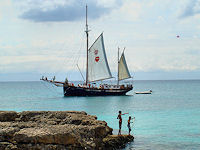
Local anglers try their luck .
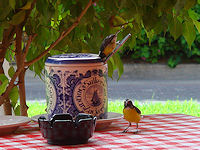
A successful crime needs a good lookout.
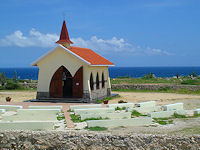
Alto Vista Chapel.
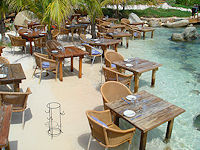
Waterfront dining.
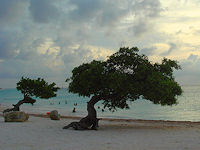
Divi Divi trees - symbols of Aruba.
|
|
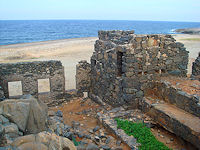
Bushiribana gold works.
|
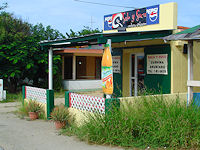
Cushino Arubiano
|
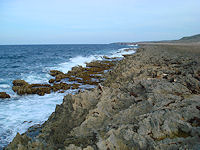
Aruba's eastern shore.
|
|
Copyright © 2005 JnDsTravelog.com. All rights reserved. |
|
|